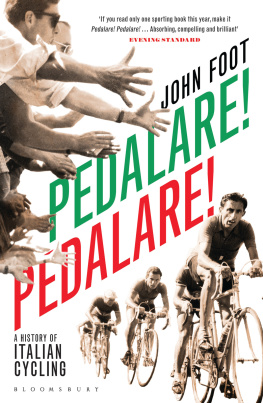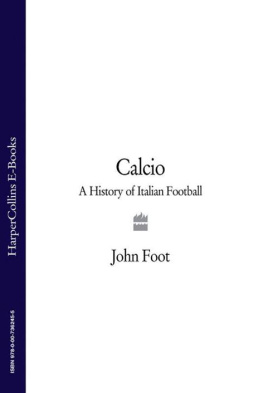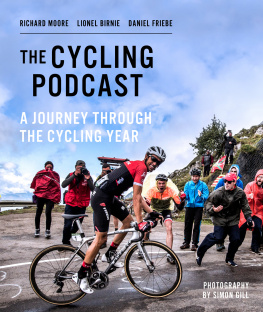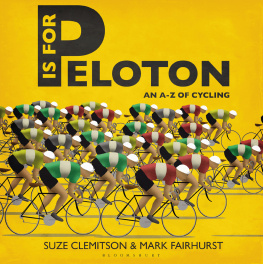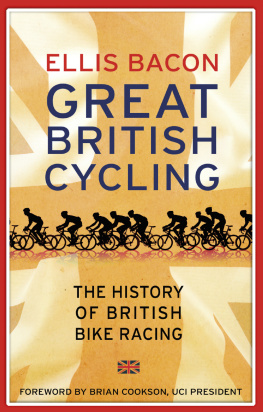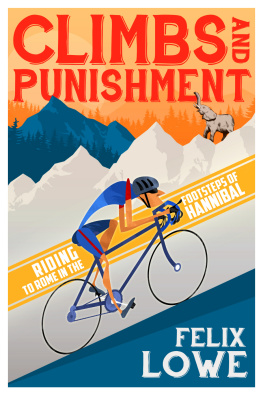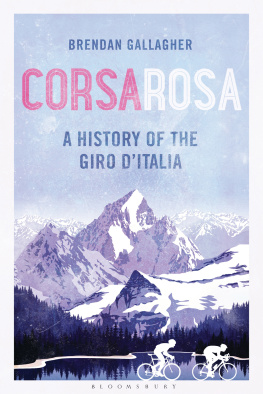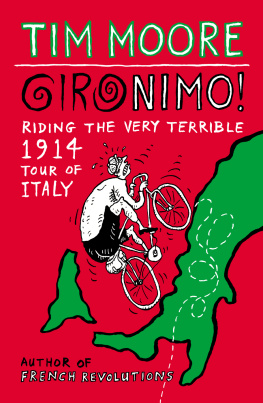PEDALARE!
PEDALARE!
A History of Italian Cycling
John Foot

To Sarah
Contents
And God created the bicycle, so that man could use it as a means for work and to help him negotiate lifes complicated journey...
Translation of the inscription at the church of Madonna del Ghisallo, the shrine of cyclists, near Como, northern Italy
Milan, northern Italy, 2007. I am in the canal area, one of the trendiest parts of the city. Once a working-class neighbourhood with its own criminal fraternity, this zone is now dominated by fashion industry employees and by the young and well-off participants in the citys movida who arrive en masse on Friday and Saturday nights. I am being led through a courtyard by a small, elegant man. He only looks about sixty but he is, in fact, over eighty years old. We come to a little door which leads down some stairs. If I hadnt been shown the way, I would never have been able to find this place. On the door is a simple inscription. It is not an auspicious entrance, but inside there is a whole world waiting to be discovered, the past , the history of Italian cycling itself.
The walls downstairs are covered with trophies and photos whose images range from some of the greatest cyclists ever to anonymous, ordinary riders. To enter this bar, with ex-professional cyclist Renzo Zanazzi, is to go back in time, to look back into history. As I walked slowly around it, with its long tables, well-stocked bar and red chairs, Zanazzi showed me all the photos, one by one. He had, after all, ridden with Italian cycling legends Fausto Coppi and Gino Bartali in the 1940s, and he had worn the leaders pink jersey during the countrys great national race, the Giro dItalia. For each image, Zanazzi had a story to tell: of races, falls, secret agreements, missed opportunities, payments and failed payments. In the corner stood a stayer, a strange motorbike once used for track sprinting. On our way out, Zanazzi gave me a bottle of potent grappa, which he had distilled himself. One glass of it, later that evening, was enough to knock me out. I was to return on other occasions to listen to his stories and tape them in his front room. He told me that he still cycled nearly every day, often with La Gazzetta dello Sport journalist Marco Pastonesi, whom he described jokingly as mio gregario (his cycling support rider, his slave, his worker).
In entering Zanazzis bar I had come across a lost world, a piece of cycling mythology. It was as if I had stepped out of a time machine. This book will take a similar journey into the past. In these pages I shall tell numerous stories and analyse them, unpick and retell legends and evoke images from a past which lives on in the present. This will not be a complete history of Italian cycling. Zanazzis bar and its contents represent a very personal albeit extremely diverse collection, and I hope that my journey will be every bit as eclectic. The story of Italian cycling has always been told and this book will not depart from that style.
Professional cycling today bears little relation to the sport in which Zanazzi participated, despite the claims of its contemporary proponents and the organisers of big races. Even Zanazzis bar is a remnant of that great past, a nostalgic space which is used, as Renzo himself told me, more as a generic meeting place for old people than a site for the discussion of cycling. Zanazzis bar is a museum piece, radically out of step with the hustle, bustle and pollution of the city above it, out there in the real world. Inside that bar you get a vision of a fascinating, sweaty, grimy and yet glorious past. Outside, it seems as if such a place could not exist. This book will attempt to take the reader into the Italy of Zanazzis bar, with its smells, tall tales, chiselled faces and arms raised at finish lines. But I shall not try to trick the reader. Lets be clear about this right from the start: Renzo Zanazzis Italy is gone, for ever . It has hung up its pedals, as the saying goes, and it will not be making a comeback. But this history still matters in contemporary Italy, and can be seen all over the country, in every nook and cranny, on every mountain top and, sometimes, in the most extraordinary and unexpected places.
If you take the state highway no. 36 out of Milan, passing through the grey, flat, almost endless periphery of the city, you eventually reach the foothills of the mountains around Lake Como. There the landscape quickly becomes spectacular, rising steeply above the Y-shaped lake before plunging down to Bellagio, a small, beautiful town situated at the end of the finger which splits the water into two parts. At the top of this peak, with views stretching over to Switzerland and back to Milan, there is a steep climb so sharp it is sometimes known as a wall up to a small church, 750 metres above sea level. Italy is full of drives like this, but this journey should not be taken by car. This is a unique site for Italian cyclists, and a key climb in one of the earliest and most celebrated one-day classic races, the Giro di Lombardia.
In October 1948, in his summer residence at Castel Gandolfo, outside Rome, Pope Pius XII lit a lamp which was called the permanent flame of the Ghisallo.
Thousands of riders make this climb every year, on what journalist Gianni Brera called the poor mans spaceship, to the Madonna del Ghisallo. There they rest and admire the view, but also take in a series of monuments and a museum dedicated to the history of cycling. One memorial depicts a cyclist who has just fallen alongside another triumphant rider. This statue is a testament to the pain and the glory of the sport of cycling, and every year, on 24 December, an annual mass for the cyclists of the past is held here. Inside the tiny church are bicycles (including the one ridden by Fausto Coppi to break the world hour record in 1942, as well as the bikes ridden by Gino Bartali to his 1938 and 1948 Tour victories), shirts and numerous photos of living and dead riders. Next door, looking out over the lake, there are statues of Coppi, Bartali and Giro dItalia organiser Vincenzo Torriani, alongside Don Ermelindo Vigan, the priest who inspired the link between this church and cycling.
The Madonna del Ghisallo is a living monument to the memory, the popularity, the beauty and the physical effort of bike riding in Italy. A number of famous riders even got married here. The shrine symbolises the sports continuing hold over the popular imagination and its intimate relationship with landscape and history.
Pedalare! Pedalare! is a history of Italian cycling from the appearance of the first bikes in Italy in the 1880s through to the birth of a mass, popular sport in the 1930s and 1940s and up to the present day. It tells the story by moving between the biographies of individual cyclists, tales of races and an analysis of Italian society. Much of the book is concerned with cycling as a professional sport, but space will also be dedicated to the role of the bicycle in everyday Italian life, from the red cyclists who spread socialist propaganda in the early twentieth century through the cycling commuters of the 1950s and 1960s, right up to the politically inspired, anti-traffic, critical mass riders who have appeared in todays cities. The book will develop chronologically, its chapters set largely around the life stories of riders, and these biographical chapters are interspersed with stories of notable races and incidents. The heroic age of the sport began with the first Giro in 1909 and later saw the bicycle used as a weapon in the First World War. Ottavio Bottecchia, the first Italian to win the Tour de France in the 1920s, had fought in one of his countrys special bicycle divisions during the conflict. Cycling became a mass sport in the 1920s and 1930s, a period which saw the emergence of Costante Girardengo, the super-champion, Alfredo Binda, the first cycling superstar, and his great rival Learco Guerra. Benito Mussolini was not very interested in cycling himself, but his regime was, and sport became a battleground for the hearts and minds of the people in the 1930s. In that battle, cycling, the most popular sport of all, played a key role.
Next page
